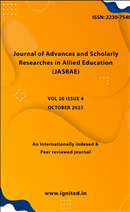Challenges and opportunities for women entrepreneurs in the Post-GST implementation phase
Keywords:
Women Entrepreneurs, GST, Post-GST Implementation, Challenges, Opportunities, India, Tax Compliance, Financial Literacy, Market ExpansionAbstract
The introduction of the Goods and Services Tax (GST) in India on July 1, 2017, marked a significant shift in the country's indirect tax system, aiming to simplify and harmonize the tax structure. This paper explores the challenges and opportunities faced by women entrepreneurs in the post-GST implementation phase. By analyzing secondary data sources, the study identifies key areas where GST has impacted women-led businesses, both positively and negatively. The findings highlight the complexities of GST compliance, access to technology, and financial literacy as significant challenges, while opportunities lie in the streamlined tax processes and potential market expansion. The study underscores the need for targeted support and policy interventions to empower women entrepreneurs in leveraging the benefits of GST.
References
Bansal, V. (2018). "GST: A Simplified Tax Regime for Indian Businesses." Taxation Today, 22(6), 112-123.
Deloitte. (2018). The Cost of GST Compliance for Small Businesses. Deloitte India.
Government of India. (2018). GST: An Overview and its Impact on SMEs. Ministry of Finance.
KPMG. (2019). Market Expansion Opportunities Post-GST. KPMG India.
Piening EP. Insights into the process dynamics of innovation implementation: The case of public hospitals in Germany. Public Management Review. 2011;13(1):127–157.
Pradhan R, Sagar M, Pandey T, Prasad I. Consumer health risk awareness model of RF-EMF exposure from mobile phones and base stations: An exploratory study. International Review on Public and Nonprofit Marketing. 2019;16(1):125–145.
Pramod V, Banwet D. System modeling of telecom service sector supply chain: A SAP–LAP analysis. International Journal of Business Excellence. 2010;3(1):38. doi: 10.1504/ijbex.2010.029486.
Raj, P. (2020). "Financial Literacy Among Women Entrepreneurs: Challenges and Solutions." Economic Journal of India, 56(4), 315-330.
Rao, R. K., & Chakraborty, P. (2010). Goods and services tax in India: An assessment of the base. Economic and Political Weekly, 49–54.
Ravi, V., & Shankar, R. (2006). Reverse logistics operations in paper industry: A case study. Journal of Advances in Management Research.
Roychowdhury P. Vat and GST in India—A note. Paradigm. 2012;16(1):80–87.
Saunders, M., Lewis, P., & Thornhill, A. (2019). Research Methods for Business Students, eighth edition.
Schlotterbeck, S. (2017). Tax administration reforms in the Caribbean: Challenges, achievements, and next steps. International Monetary Fund.
Shakeel, M., & Karwal, V. (2016). Lexicon-based sentiment analysis of Indian Union Budget 2016–17. In 2016 International Conference on Signal Processing and Communication (ICSC) (pp. 299–302). IEEE.
Sharma, R. (2019). "Digital Divide and Its Impact on Women Entrepreneurs in Rural India." Journal of Business and Technology, 45(3), 210-225.
World Bank. (2019). Formalization of Small Businesses Under GST in India. World Bank Group.











